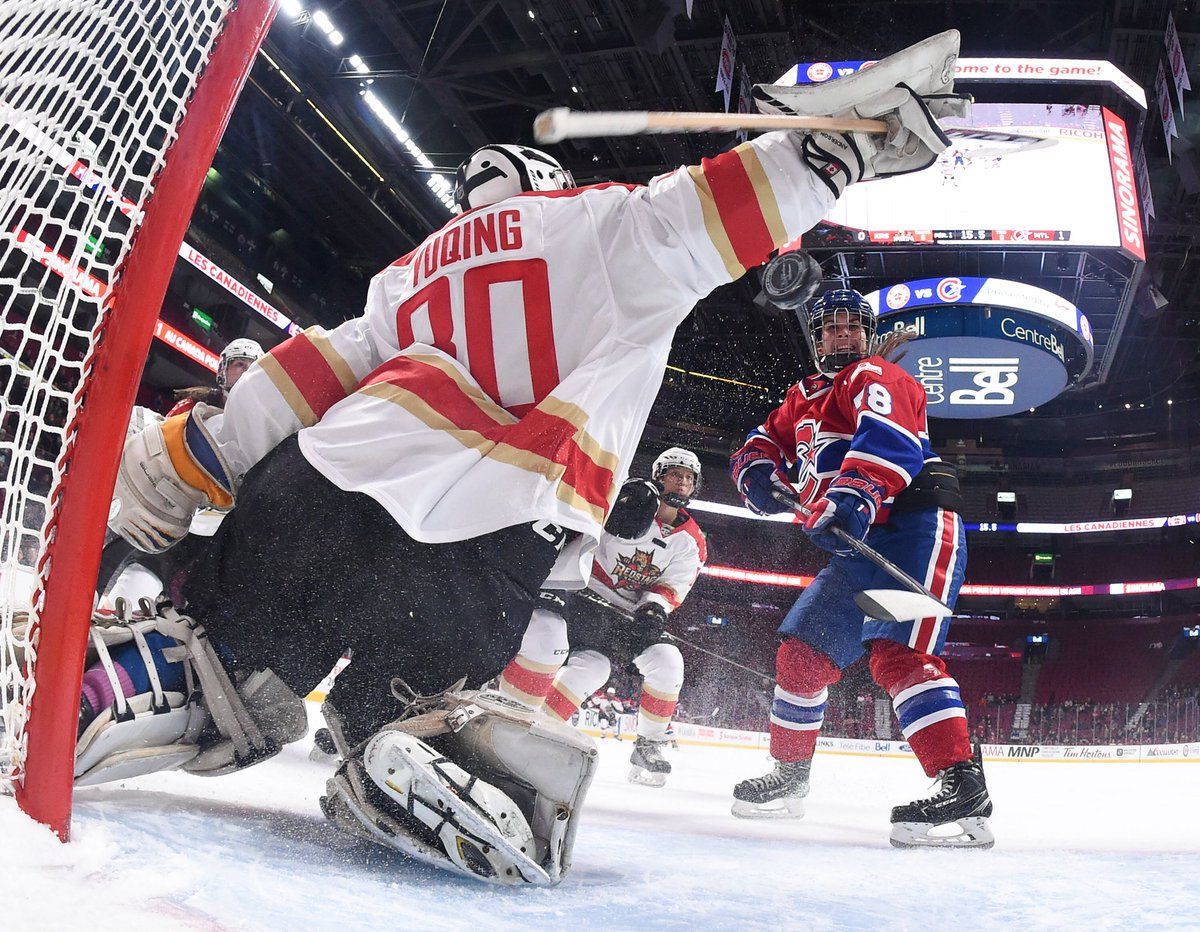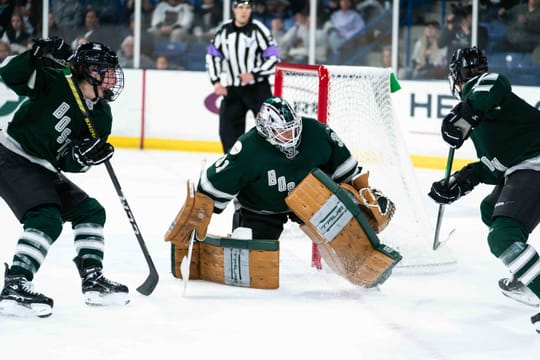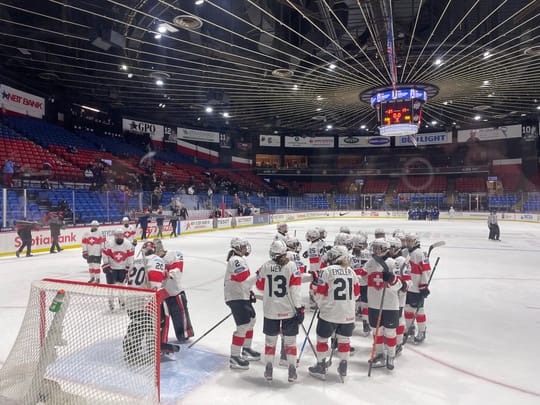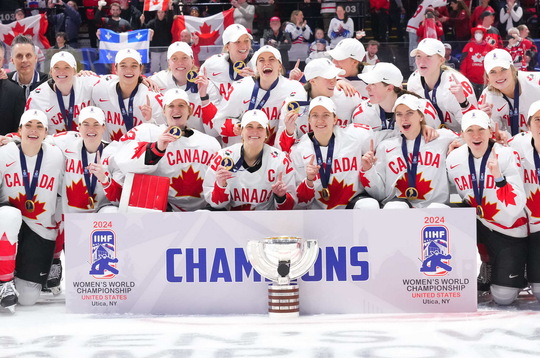Ask anyone around the Chinese national women's program, and they will tell you that the structure put in place this past season -- with teams in the CWHL and the Eastern Women's Hockey Conference -- is part of a five-year plan, and that it is going to take all five of those years to truly see the results. But year one of that plan culminates this week, as Team China competes in the IIHF Division IB Women's World Championship in Asiago, Italy. The tournament, which runs from April 8-14, is the first chance to evaluate the impact of the change on the Chinese national team's on-ice performance.
China finished fourth of six teams in the 2017 tournament, despite goaltender Wang Yuqing (Sherry) posting the best save percentage (.946) and goals-against average (1.19) of the competition. This year, they'll face newly-promoted Korea, and re-match Italy, Kazakhstan, Latvia, and Poland in a round-robin format. Both of their losses in 2017 were by just one goal, and the division remains quite evenly matched. China's official entry list for the 2018 tournament includes 21 skaters and three goalies. Though a mini-camp was held in Shenzhen in February for Chinese athletes who are not currently in the CWHL, players from the league make up the bulk of the roster. Two skaters played for the Kunlun Red Star U18 team in the EWHC, while the rest spent the year with either the senior Kunlun Red Star or the Vanke Rays.
When Kunlun and Vanke entered the league, their rosters were constructed with a plan. China's top defenders -- Yu Baiwei (Berry) and Liu Zhixin -- went to the Red Star, where they'd practice day-in and day-out against international-calibre forwards, play in front of a world-class goalie, and compete against the most dangerous opponents in the league. Both Yu and Liu played huge minutes all season, as one of just two defensive pairings on KRS. Meanwhile, the best forwards went to Vanke, where they'd earn regular ice time against top competition. The goal was to place specific Chinese national players in situations that would best foster their individual development, and for younger players in particular, the practice environments were deemed just as important as the game line-ups. Yu and Liu, along with Rays forwards Fang Xin (Turbo) and Kong Minghui (Summer), are expected to form the core leadership group of the national team.
One of the main criticisms of Kunlun and Vanke throughout the season was that many Chinese nationals saw minimal ice time. This is where you're reminded that it's a five-year plan.
"You can't grow great hockey players overnight, and I keep saying it's a marathon, not a sprint," said Digit Murphy, who serves as head coach of both the Red Star and Team China. "Hockey is something that is learned over time and you're trained over time. What we've found with the Chinese athletes is they've been on the ice a lot, they've been doing skills a lot, but the whole educational piece -- the systems, just how to be coached -- is something that they're still developing.
"They're good students, but it takes time. They're going to do the best they can, we're going to do the best we can, but it's not going to be this instant success that people think just because you throw resources at it, it's going to happen. Hockey is one of the most difficult sports to play on the planet. It's going to take time, but we're optimistic."
In January, Zoë Hayden wrote about the Kunlun Red Star club system and its impact on pre-existing hockey development structures in China. When the Kunlun Red Star Hockey Club expanded into a national club structure last spring, announcing the addition of nationally-sourced teams that would play in various leagues in Russia and North America, the Chinese Ice Hockey Association essentially handed over much of its elite player development to the KRS organization.
Grassroots development is a priority for those around the women's national team, though instituting girls' hockey programs doesn't quite fall under their direct purview. As much as the CWHL is crucial in providing competitive opportunities for top players, Murphy is quick to precise that it is not the CWHL that is responsible for the growth of hockey in China. Rather, it is the Kunlun Red Star organization (the club as a whole, not just the women's team) aiming to grow hockey in the country; fielding teams in the CWHL is just one part of the club's initiative. While some fear that 2022 will mark the end date of China's interest in the sport, both Murphy and Vanke head coach Rob Morgan, who serves as an assistant with Team China, see it as a potential spark.
"If we can improve the base of the Chinese nationals in conjunction with some of these heritage players to play in the Olympics in 2022, that's kind of a stop-gap for the rest of the Chinese and how we're trying to grow the game for those five years," Murphy explained. "The real true test is how many kids are going to play between the ages now of eight and fourteen that we start to grow the base of, so that China can take care of itself in the global spectrum. This is kind of like that stop-gap, so when they get to Beijing 2022, just like in Korea, they're competing. Then that model, hopefully, will catapult the interest in hockey to the rest of the population."
Ultimately, this is the same model seen with any sport or team that is trying to break into a new market: do well in order to attract attention. In the same way that gold medals in Nagano 1998 and Salt Lake City 2002, respectively, propelled girls' hockey registration in the U.S. and Canada, the objective for China is to ice a competitive team on the biggest stage in 2022. The hope is that a strong performance at those home Olympic Games will draw more girls to hockey, and that by that point, the infrastructure will be in place to continue the growth of the sport. In many ways, 2022 is seen to be as much of a beginning as it is an end goal.
"It's just a matter of putting -- whether it's a model that's similar to Hockey Canada or the American Development Model -- putting that in place and planting those seeds for those young kids to get excited about hockey," said Morgan. "You should see the little girls that came out to watch us play. They're up there dancing and cheering just like they are here [in Montreal]. Now we've got to get them on skates."
At this early stage of the plan, winning at the club level is important in creating excitement to showcase the game -- the Clarkson Cup Final between Kunlun and the Markham Thunder was broadcast live on multiple Chinese networks, complete with intermission interviews. Icing a winning team in an extremely competitive league comes at a cost, though, and there's a delicate balance to be struck between distributing playing time and maximizing exposure. Murphy hopes that the teams' success on the ice will continue to attract attention, and that seeing women who look like them will inspire girls in the audience to take up the sport.
"You speak of a group of 5000 people in the stands, there's a lot of kids," she noted. "I think that that audience starts to say 'Wow, I like hockey and I want to play it.' Our initiative is to win, or to play well and competitively in the CWHL, so that people like hockey. People like winners. So when you combine trying to teach the game and educate the game with a winning product -- when players are scoring goals and they're cheering for your players, but they see the Chinese faces like the Maddie Woos or the Mel Jues or the Jess Wongs scoring goals, or the Turbos or the Elsas or the Summers of Vanke scoring goals, then those Chinese kids want to grow up and be them as hockey players."
Kunlun's sport ambassadors insist that the growth they've witnessed in their Chinese teammates has been incredible. Some viewers have questioned whether the Red Star's success within the CWHL can really be considered representative of the Chinese national program. The answer is simple: it can't. That's what Worlds are for.
"I wish you could see it on video, the first day that we all met and were in a locker room together," said Jessica Wong. "To see them now, stickhandling, competing with Olympians, I think you can see [the development] for yourself."
Wong and other ambassadors emphasize a focus on proper nutrition, rest, and off-ice conditioning as some of the most important things they've instituted with their Chinese teammates. Many of the players had never done weight training before: it simply wasn't part of their program. The difference comes in the form of "those little things that some people would never think of," she said; the lifestyle adjustments that help fuel athletic performance.
"Four years is short," she added. "It's definitely going to take some time and it's going to take the four years to be at that level, and it's going to take a lot of hard work from the girls. They're going to all have to buy in and stay motivated. I think it's definitely reachable -- seeing Japan and Korea, how they're doing things now and how they're competing -- I do believe in the girls and I believe in the sports ambassadors that we have. It's the hard work that we've put in, and we're so happy to help them as much as we can and [share] the resources that we have that we can give to them."
For Wong, who, like several of the Chinese-North Americans on Kunlun and Vanke, was retired and working within hockey before joining the team, the mission is personal. She hopes to have a chance to represent China at the Olympics in 2022, but even without that, she's embracing the opportunity to give back to the game she loves in the province where her grandmother was born.
"Honestly, it's what I've always wanted to do," she said. "Especially with half my heritage, Chinese players, this is a dream come true. To play, but alongside [that] help these girls grow and hopefully medal, it's a great feeling and I'm so happy to be here."
Noora Räty, too, is invested in the dual role ambassadors have. She began coaching after she graduated from the University of Minnesota in 2013, and says she immediately fell in love with it.
"When they told me that one of my jobs is to stop pucks, but I'd also be mentoring two Chinese goalies, I was on board right away," she said. "I think life would be boring just to play. I like the fact that I get to mentor and give back for Sherry and [He] Siye."
Wang followed up her stellar performance at 2017 Worlds with a strong showing in the CWHL. The 23-year-old recorded a .905 save percentage and 1.98 GAA through 425 minutes of play, including six full games, most notably backstopping the Red Star to a win over defending-champion Montreal at the Bell Centre in her debut. The less-experienced He played just two games, finishing with a .909 SV% and a 2.66 GAA, but Räty sees huge potential in the young goalie.
"Siye's only 19 years old, so by 2022, she has the whole Team China on her shoulders," Räty projected.
This will mark He's third World Championship. She was first rostered at age 17 in 2015-16, but has yet to suit up in a game. China's young goaltending situation will be something to watch for, both at Worlds and in the years to come.
The role of ambassadors moving forward is something else worth watching. Räty said they haven't yet discussed next season, though she'll be back if they'll have her. Murphy noted that because it's the first year this has been done, the position remains in flux -- it's possible that the expectations change as the program better discovers its needs.
For the young Chinese players, the presence of the ambassadors provided an off-ice framework and overall training environment that likely did benefit even those who saw little game action during the CWHL season. Still, going a full year with limited competitive experience is a risk. There were whispers earlier in the year that some Chinese-North Americans would play for China at Worlds, but they don't yet meet IIHF eligibility requirements (which include citizenship, among other things). Instead, these World Championships will be the first real chance to see how the development of the younger Chinese nationals will translate from practice to play.
Moving into Worlds from the CWHL season naturally requires some adjustments. With Kunlun, Murphy said she "completely undercoaches," preferring to allow players space to create ideas and find their own solutions. A core tenet of her philosophy involves inviting athletes to think through the game plan themselves, which she said translates to their ability to make decisions on the fly during play. Her role completely changes when she moves to the Chinese national team, where she takes a more hands-on, mentor-teacher approach.
"But that's easy," she added. "I did that my whole life."
Though much of the narrative around Kunlun and Vanke has centred on the introduction of North American and European development models, the change goes deeper than that. China has had North American coaches before. The one Murphy inherited the team from, Rick Seeley, has a track record -- and not a good one. Seeley has been accused of verbal, physical, and mental abuse by players he coached at both Clarkson University and Quinnipiac University. Murphy said her work with the national team has been as much a process of unlearning as of teaching.
"It's a thousand percent different," she said of the team culture. "They would not go out of their hotel rooms when I first got them. They wouldn't leave without me telling them."
Restoring the athletes' autonomy has been a key objective. Murphy described a moment early in the season when Yu, a veteran with over a decade of experience on the national team, refused to join teammate Kelli Stack for a leisure activity without being granted express permission from the coach -- something that had always been required of the Chinese athletes. It's been a process, she said, to encourage them to take time to enjoy themselves and feel empowered to make their own choices.
"Hockey's about decision-making," Murphy added. "If you can't make your decision-making in life, when to get out of bed and when to do whatever, you can't be a good hockey player. So all these off-ice lessons, you have to put them in that. They're going to get better and better because of their growth mindset. It's not [about] limiting: it's growing, it's empowering."
China opens its tournament against Poland at 11:00 AM Eastern on Sunday, April 8. All games will be streamed live by the IIHF.
(Photo: Montreal Canadiens/Twitter)







